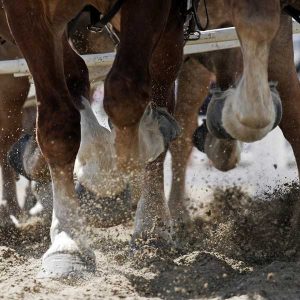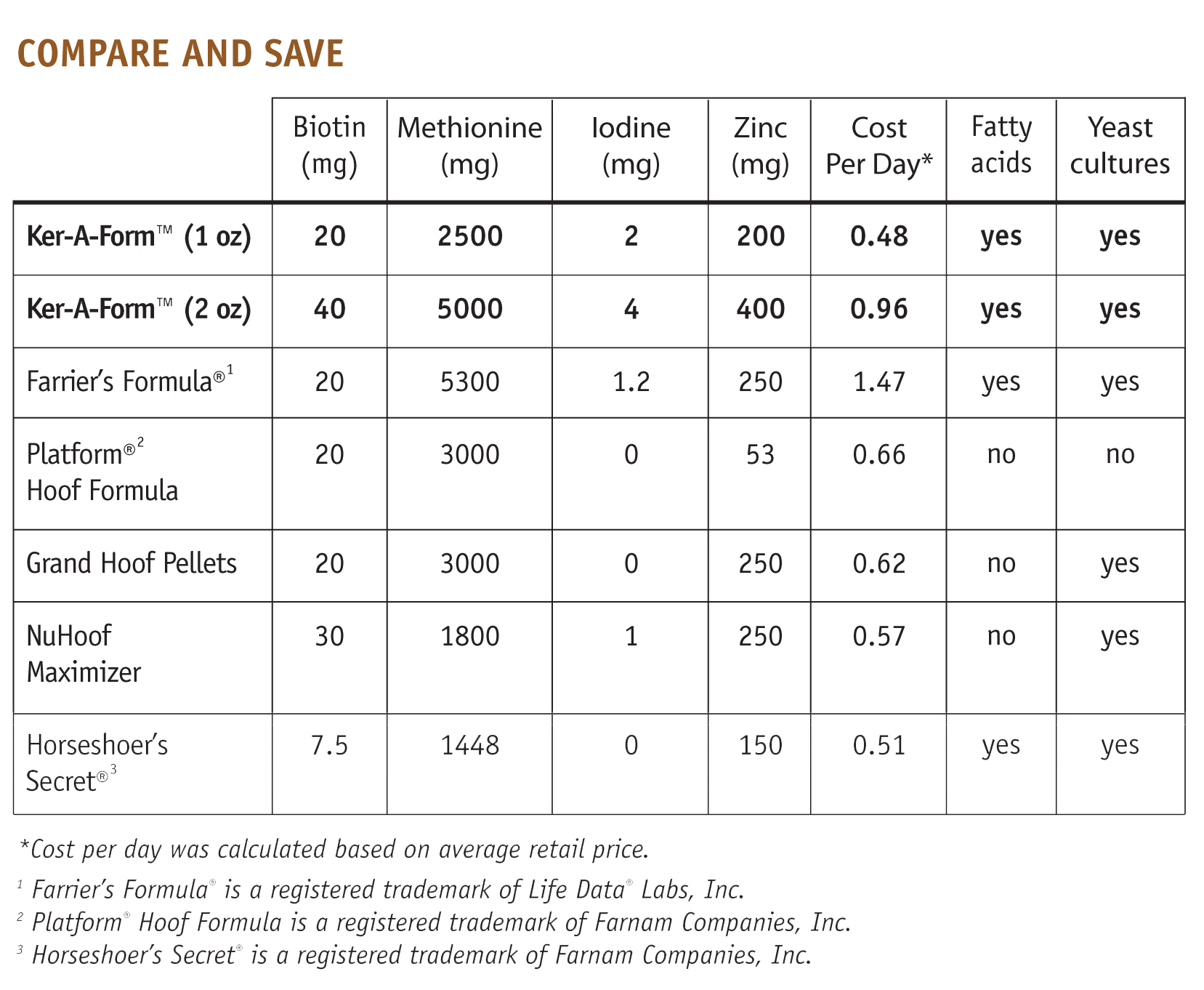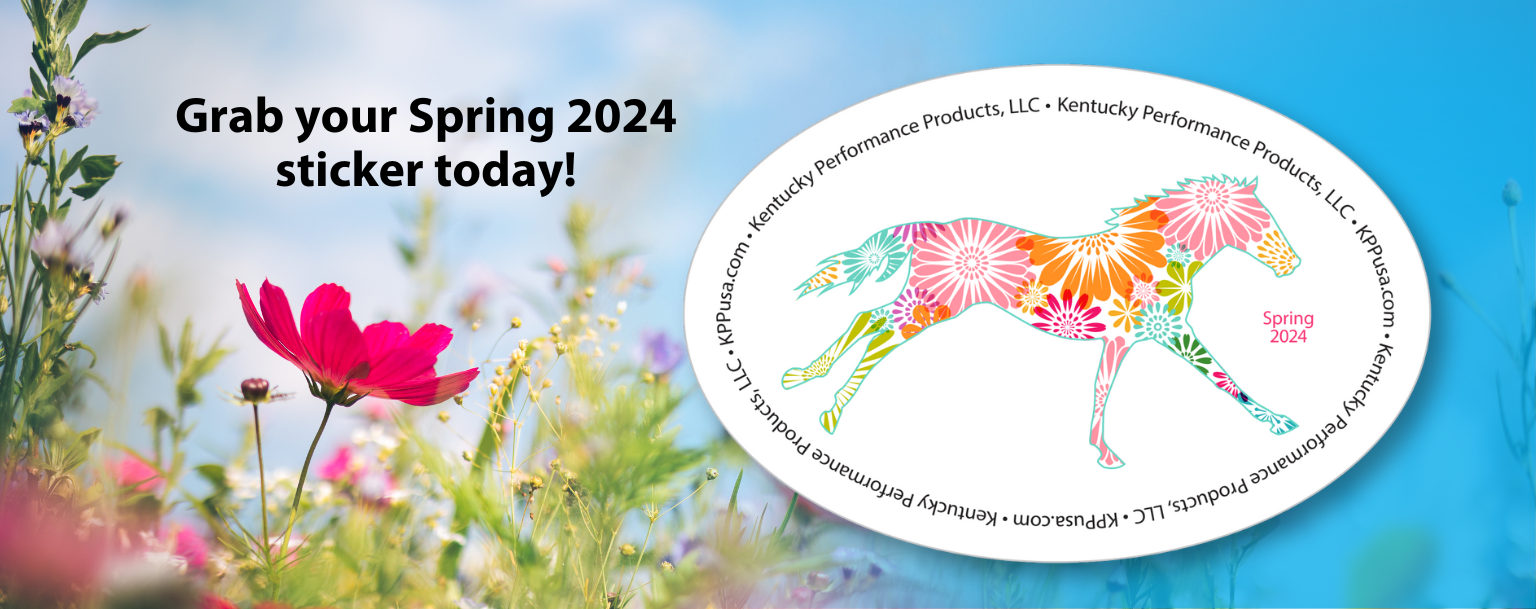
Getting the Most for Your Money with Ker-A-Form™
Providing proper nutrition for your horse is one of the most basic ways to ensure his well-being. High-quality forage and well-formulated, properly fortified concentrates should provide the basis for his diet. Occasionally, however, these components are not enough to guarantee optimal health. In cases in which beneficial nutrients cannot be delivered through a diet of forage and concentrate, scientifically proven supplements should be considered. Care should be taken to read and understand the reason why certain ingredients are included in a given product. Then and only then can a judgment be made on the true value of a supplement—from a nutritional standpoint as well as a monetary one.
One example of this is biotin. Horsemen, farriers, and veterinarians agree that problem hooves are often helped significantly through supplementation with biotin. Although it takes considerable time for a horse to grow an entire hoof, sometimes a year or more, new hoof growth at the coronary band is often markedly different from old. Stronger feet have multiple advantages: they hold shoes longer, they are less likely to crack and crumble, and they are less prone to debilitating conditions such as white line disease. Therefore, the value of biotin as a nutritional supplement is well known.
Next, the price sticker on a biotin supplement must also represent value. Simply put, the product must be worth the price you have to pay.
Kentucky Performance Products (KPP) markets Ker-A-Form, a hoof and coat supplement that features biotin as a primary ingredient. Ker-A-Form sits on feed and tack stores shelves among many other hoof supplements. What makes it different from the pail of hoof supplement that is displayed next to it? What makes it a good value for your money?
This is key: Ker-A-Form contains more than biotin. It also supplies horses with nutrients to build strong hooves, including essential amino acids and microminerals.
On a dry matter basis, hoof is thought to be approximately 93% protein, with at least 11 individual amino acids recognized (Coenen and Spitzlei, 1997). In supplementing for healthy hooves, it therefore becomes imperative to provide horses with a high-quality protein source. A main ingredient in Ker-A-Form is full-fat soybeans, a processed legume that is abundant in amino acids. In fact, full-fat soybeans contain the highest quality protein and the greatest amount of lysine of any plant-source protein supplement. In addition to lysine, Ker-A-Form supplies horses with methionine, yet another essential amino acid, as well as a host of other essential amino acids necessary for optimal hoof growth.
Aside from essential amino acids, microminerals like iodine and zinc are part of the formulation. Research has shown that horses consuming a diet deficient in zinc and copper were more likely to be diagnosed with white line disease, a painful and debilitating hoof ailment, than horses that were supplemented with higher levels of these minerals (Hihami, 1999). A study performed by Coenen and Spitzlei (1997) demonstrated that supplementation with 300-500 mg of zinc per day led to increased zinc concentration in the hoof. The addition of Ker-A-Form to a well-balanced diet that includes a fortified feed makes certain that the zinc requirement is fulfilled.
Some researchers believe that the form of zinc offered is important when trying to improve hoof condition, with organic minerals more highly digestible than inorganic minerals. Zinc proteinate is a form of organic zinc found in Ker-A-Form. Organic mineral sources such as zinc proteinate have undergone a process called chelation in which the mineral is bound to an amino acid. Because amino acids are readily absorbed from the gastrointestinal tract, zinc absorption is thought to improve when the mineral is chemically attached to an amino acid.
Iodine is less frequently included in hoof-building supplements. Ker-A-Form contains the mineral because of its known effects on coat condition. Iodine deficiency can cause a dry, lusterless coat, and patchy or diffuse hair loss (Fadok and Wild, 1983).
Moreover, Ker-A-Form also acts as a coat conditioner due to the inclusion of full-fat soybeans. These soybeans are a source of omega-3 and omega-6 fatty acids. Addition of fat to the diet adds pliability to the skin and bloom to the coat. Few other hoof supplements offer these benefits and those that do are usually more expensive than Ker-A-Form.
In these pinch-penny times, it’s good to know you’re getting the most value for your dollar. With pencil and calculator in hand, take the time to figure out which products offer the most benefits. Like most consumers, you want to get the most value for your dollar.
References
Coenen, M. and Spitzlei, S. 1997. The composition of equine hoof horn with regard to its quality (hardness) and nutrient supply of horses. Proc. Equine Nutr. Physiol. Symp. 15: 209-212.
Fadok, V.A., and Wild, S. 1983. Suspected cutaneous idodinism in a horse. J. Amer. Vet. Med. Assoc. 183:1104.
Hihami, A. 1990. Occurrence of white line disease in performance horses fed low-zinc and low-copper diets. J. Equine Sci. 10:1-5.


